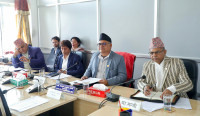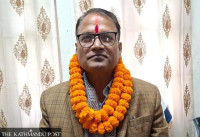National
Oli aims for 70 percent SEE success rate. Experts wonder how
Secondary Education Examinations results must improve by around 50 percent to meet Oli’s claim.
Binod Ghimire
Ever since taking charge as prime minister in July, KP Sharma Oli, who also chairs the CPN-UML, has been claiming that the Secondary Education Examinations (SEE) graduation rate will see a big uptick starting with the next edition of the test.
Addressing a UML gathering in the Capital last week, he claimed that 70 percent of the SEE examinees will pass the test to be held in March next year. Oli has set an ambitious target when over a half of the examinees taking the garde 10th board exam got disqualified in the test results published a few months back.
Back then, only 222,472 students—47.87 percent—managed to secure a Grade Point Average (GPA) above 1.60, which is necessary to study at a higher level. Among 464,785 students who appeared in grade 10 final tests, 242,313 students—52.13 percent—were categorised as non-graded. However, later, over a third of them were graded, qualifying them to study in grade 11 after the supplementary exams.
The SEE results must improve by around 50 percent to meet Oli’s claim. However, with less than four months to go, the government hasn’t taken any concrete measures to improve the learning environment to meet the 70 percent target.
Binay Kusiyait, a professor who has conducted research on school education, claims that the graduation rate cannot increase significantly under the given conditions.
He says boosting teachers’ capacity, improving the learning environment, modifying the curricula, and bettering the overall school environment can improve the success rate. But nothing to this effect has been done, he laments.
“Playing with the evaluation system is the only way to achieve the 70 percent target this year. There is otherwise no way the results can improve so fast,” Kusiyait told the Post. He said the government can set a target higher than 70 percent but only after improving the current state of schools. “Any target can be achieved with proper 5-6 years of planning and execution,” he said.
Over the years, the education budget has been stagnant, there is a gross shortage of subject teachers even as the sector’s politicisation hasn’t abated.
Most schools across the country lack adequate teachers, mostly for Mathematics, English and Science that have the highest failure rates. Different reports by the ministry have pointed out an acute shortage of the subject teachers.
A panel led by Janardan Nepal, then joint-secretary at the Ministry of Education, had suggested in 2009 that the government add 50,000 new teacher positions from the pre-primary level to grade 12. The report was left unimplemented, and the government went on to form another panel led by Mahashram Sharma 10 years later, in 2019.
Sharma’s committee had suggested that 57,056 additional positions of teachers be created to ensure a smooth teaching-learning process at schools. But, as yet, no efforts have been made to recruit the necessary teachers.
Kusiyait said he had asked Education Minister Bidya Bhattarai how the SEE results could be improved without drastic intervention in under a year. “She had no answer,” he said.
Government officials claim to be taking measures to ensure that the students perform better this time.
Laxmi Prasad Bhattarai, spokesperson for the ministry, said the focus is on extra online classes, improving classroom learning and having a better evaluation system. He said a team was mobilised to collect the record of the students from the schools that don’t have subject teachers. “Online classes will focus more on those students,” he told the Post.
But this is not the first time the government has launched online classes. This has been a regular thing after the Covid pandemic. The SEE-targeted virtual classes through television and radio have been held for years now. But they are yet to yield expected results.
Bhattarai said a team led by former education secretary Shankar Pandey is studying the overall school-level evaluation system, which will also suggest reviewing the SEE evaluation system.
“I have heard that the panel could recommend that the students who receive 35 marks combined from theoretical and practical exams will be categorised as graded. This is how the government wants to have better results,” said Kusiyait.
Currently, each SEE student must score at least 35 percent mark in theoretical exams to qualify for higher studies. Students failing to get the score in theoretical exams will not be eligible to enrol in class 11 and will receive their results in the non-graded category as separate grading for theoretical and practical exams have been adopted.
Each subject, including Mathematics, will have a 25-mark practical test and a 75-mark theoretical exam. Students have to secure 27 marks in the theoretical part. Practicals are conducted by the schools themselves, and the obtained marks are sent to the board.




 8.12°C Kathmandu
8.12°C Kathmandu















